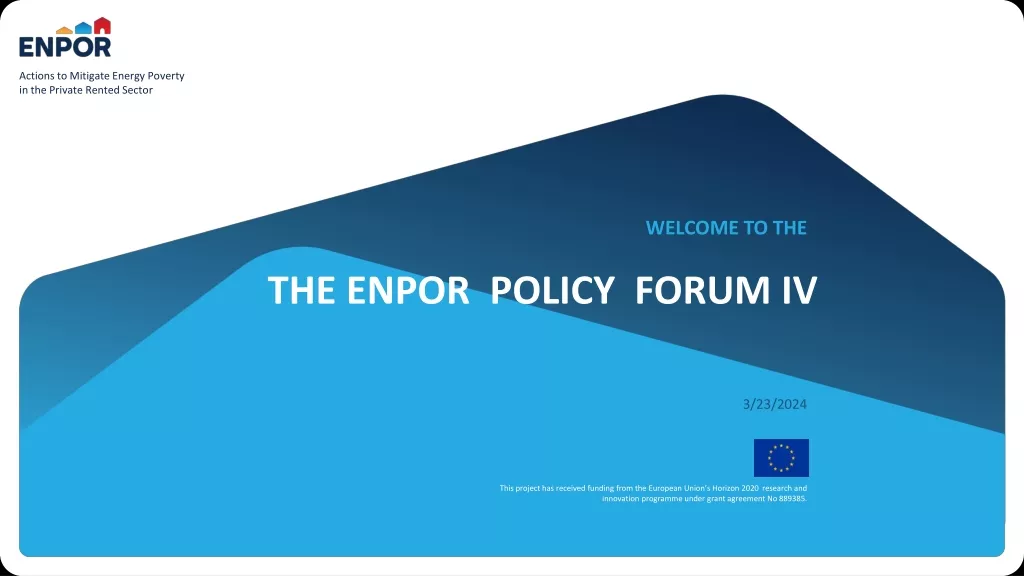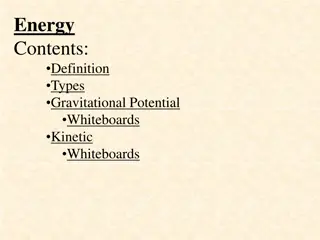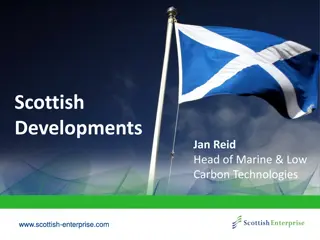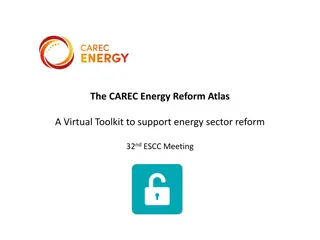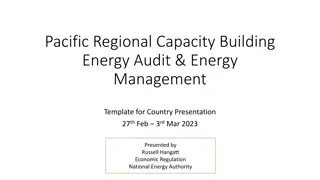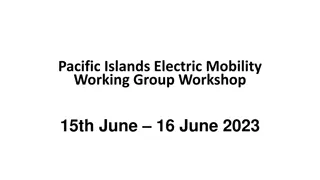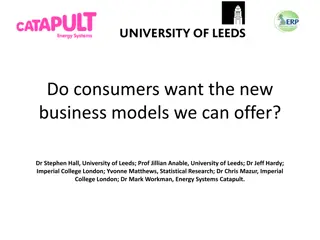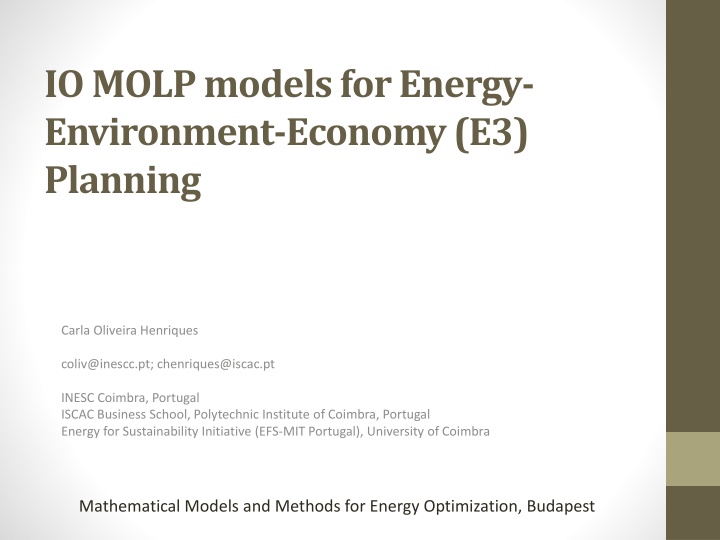
Energy Sector and OR Models: A Comprehensive Overview
The energy sector has seen significant advancements in the application of operational research models for energy planning, with a focus on multi-objective optimization and multi-criteria analysis. These approaches have become essential for addressing complex sustainability issues and decision-making challenges in the energy industry. From historical applications to modern uses, this overview explores the evolution and importance of OR models in energy planning.
Download Presentation

Please find below an Image/Link to download the presentation.
The content on the website is provided AS IS for your information and personal use only. It may not be sold, licensed, or shared on other websites without obtaining consent from the author. If you encounter any issues during the download, it is possible that the publisher has removed the file from their server.
You are allowed to download the files provided on this website for personal or commercial use, subject to the condition that they are used lawfully. All files are the property of their respective owners.
The content on the website is provided AS IS for your information and personal use only. It may not be sold, licensed, or shared on other websites without obtaining consent from the author.
E N D
Presentation Transcript
IO MOLP modelsfor Energy- Environment-Economy(E3) Planning Carla Oliveira Henriques coliv@inescc.pt; chenriques@iscac.pt INESC Coimbra, Portugal ISCAC Business School, Polytechnic Institute of Coimbra, Portugal Energy for Sustainability Initiative (EFS-MIT Portugal), University of Coimbra Mathematical Models and Methods for Energy Optimization, Budapest
Outline The Energy Sector and OR Energy-Environment-Economy models IO MOLP models (why?) Some basic features on IO Theoretical underpinning of IO MOLP models IO hybrid approaches Uncertainty handling of IO MOLP models A review on IO MOLP models IO LP models IO MOLP models IO LP and IO MOLP with uncertainty handling techniques LP dynamic IO models and MOLP dynamic IO models IO LP and IO MOLP with Data Envelopment Analysis (DEA) MOLP techniques for updating the IO matrix Conclusions 2
The Energy sector and OR The energy sector has been a fertile ground for the application of operational research (OR) models and methods The first historical applications of multi-objective optimization (MOO) / multi- criteria analysis (MCA) in energy planning date back to the late 1970s, namely concerning power generation expansion planning or the choice of sites for nuclear and fossil-fired generation plants. The need to consider explicitly multiple uses of water resource systems or environmental aspects in energy planning provided the main motivation for the use of MOO and MCA models and methods with a special evidence in scientific literature since the 1980s. The increasing need to account for sustainability issues, which is inherently a multi-criteria concept, in planning and operational decisions, the changes in the organization of energy markets, the conflicting views of several stakeholders, the prevalent uncertainty associated with energy models, have made MOO and MCA approaches indispensable to deal with complex and challenging problems in the energy sector. 3
The Energy sector and OR MOO and MCA approaches are essential for a thorough analysis of energy problems at different decision levels, from strategic to operational, and with different timeframes. Planning Typical timeframe Examples of decisions to be made Long- term/Strategic Several years-decades Generation expansion planning Transmission facility expansion Siting of new power plants Energy-environment-economy models for policy design Market design Operational Months-years Generation scheduling Transmission scheduling Reactive power planning Unit commitment Power flow Demand-side management Short-term Hours-days-weeks 4 Categories of planning problems in power systems according to the organizational level and time frame
Energy-Environment-Economy models The study of the interactions between the economy (at national or regional levels), the energy sector and the corresponding impacts on the environment inherently involves multiple axes of evaluation of distinct policies. In general, MOO models for this purpose are developed based on input-output (IO) analysis or general equilibrium models (GEM). The analytical framework of IO enables to model the interactions between the whole economy and the energy sector, thus identifying the energy required for the provision of goods and services in an economy and also quantifying the corresponding pollutant emissions. GEM include interrelated markets and represent the (sub-)systems (energy, environment, economy) and the dynamic mechanisms of agent s behavior to compute the competitive market equilibrium and determine the optimal balance for energy demand/supply and emissions/abatement. 5
IO MOLP models (why?) There has been a growing interest in scientific literature on the study of the causal relationship between energy consumption and economic growth and the corresponding environmental impacts. This research avenue was triggered by the oil crisis in the 1970s, caused by the peaking of oil demand in major industrial nations and embargoes from producer countries. Although the nexus between energy consumption and economic growth has yielded mixed and inconsistent results in terms of their causal relationships, its appraisal is fundamental for the economic and energy decision-making process. 6
IO MOLP models (Why?) Many countries do not possess indigenous energy resources and generally depend on primary energy imports such as crude oil, natural gas and coal. In such situations a positive relationship between energy consumption and economic growth might be expected. As a result, economic growth is usually responsible for an increase of energy consumption which heavily relies on fossil fuels, being both responsible for the depletion of finite resources and for the emission of Greenhouse Gases (GHG). Finally, energy and environmental policies may induce negative effects on economic growth and social welfare. Therefore, the merits of energy plans and policies cannot be judged by considering just economic concerns, but other evaluation aspects such as environmental and social welfare impacts, should be explicitly taken into account to address energy problems in a societal perspective (Antunes and Oliveira, 2014). 7
IO MOLP models (Why?) Thus, it is particularly relevant for planners and decision- makers (DM) to assess the trade-offs between economic growth, energy demand/supply, as well as their corresponding environmental and social effects through the use of consistent tools for supporting the process of policy decision-making. In this context, the use of multiobjective programming models and methods coupled with IO analysis seem particularly suited for helping in the process of (Energy- Environment-Economy-Social) E3S policy design. 8
IO MOLP models (Why?) Several countries compile IO tables for their economies at regular time intervals as a national statistical requirement providing an overarching framework that describes a coherent, consistent and integrated set of macroeconomic accounts forming a basis for economic analysis and policy formulation. In this context, IO analysis is an analytical tool adequate for the evaluation of the inter-relations between different economic activities having evolved and being often applied to assess E3 interactions. 9
IO MOLP models (Why?) Less known, but also acknowledged is the fact that IO has influenced linear programming (LP) in its early development. In fact, IO analysis may be regarded as a simple particular case of LP. Inter/intra-sector relations embedded in IO analysis allow designing the production possibility frontier. LP models enable choosing the optimum level of activities to optimize a given objective function, satisfying the production sector relations imposed by IO analysis. Finally, IO multiobjective linear programming (MOLP) models allow studying different efficient possibilities of production (i.e. output levels for each activity sector for which no other feasible solution exists that allows improving the value of a given objective function without worsening the value of, at least, other objective function) consistent with the conflicting and incommensurable axes of evaluation inherently at stake. 10
Some basic features on IO IO Analysis has been traditionally used to study the inter/intra-linkages between the different sectors in an economic system. In its most basic form, an IO model consists of a system of linear equations, each one of which describing the distribution of an industry s output throughout the economy. 11
Some basic features on IO The total output of an activity sector i (xi) is delivered for intermediate consumption and/or final demand. Equation (1) gives the distribution of the total output of each sector: n m + x y xi= (1) = = 1 j 1 j ij ij where xiis the output of sector i, xijis the input from sector i to sector j, and yijis the input of sector i to final demand sector j. 12
Some basic features on IO Considering the hypothesis of constant returns to scale, Equation (1) becomes: n m + xi= (2) = = 1 j 1 j a x y ij j ij in which the coefficients aijare the amount of input delivered by sector i to sector j per unit of sector's j output, also known as technological coefficients (or direct coefficients). 13
Some basic features on IO Analogously, equation (3) gives the total primary inputs of each sector: p n + xj= (3) = = 1 i 1 i x z ij ij where zijis the primary input from sector i to sector j. Then, similarly to (2) and considering (3), equation (4) is obtained: p n + a x w x xj= (4) j 1 i 1 i = = ij j ij where the coefficients wijare the amount of primary input delivered by sector i to sector j per unit of sector s j output. 14
Some basic features on IO The values of the transaction IO matrix may be then distributed by considering n activity sectors, m final demand sectors and p primary inputs . 15 Possible schematic representation of a classical IO transaction table
Some basic features on IO From (2), and considering final demand aggregated into a single vector, the productive system at a national level can then be represented in its matrix form following the basic IO system of equations (5): x = Ax + y, (5) where A is a matrix of technological coefficients, y is a vector of final demand, and x is a vector of the corresponding outputs. In order to finally obtain the output multipliers, the Leontief inverse matrix needs to be derived. Equation (5) can then be rearranged to: Ax + y = Ix Ix Ax = y (I A)x = y x = (I A)-1y, (6) where I is the identity matrix with convenient dimensions and (I A)-1is also known as the Leontief inverse. Each generic element of (I A)-1represents the total amount of good or service i directly and indirectly needed to deliver a unit of final demand of good or service j. In fact, the Leontief inverse indicates the direct and indirect requirements of production that are needed to satisfy a particular final demand vector. 16
Some basic features on IO Since the late 1960s the IO framework has been extended to account for environmental pollution generation and abatement associated with inter-industry activity . Miller and Blair (2009) have considered three basic categories of environmental IO models: generalized IO models including additional rows and columns within the IO system to incorporate the pollution generation and abatement activities; economic ecological models utilizing intra/inter-sector sub-matrices linking the economic and ecosystems sectors; commodity by industry models expressing environmental factors as commodities in a commodity-by-industry IO table. An external expansion of the IO framework can also be considered to incorporate the environmental impacts, assuming a proportional relation between the output of the sectors and the corresponding impact levels. 17
Some basic features on IO A very simple approach to accounting for pollution generation associated with inter-industry activity is to first assume a matrix of pollution output or direct impact coefficients, R, where each generic element, rkj, is the amount of pollutant type k, generated per monetary unit of industry j s output. Therefore, the level of pollution associated with a given vector of total outputs can be expressed as: r = Rx (7) where r is the vector of pollution levels. Thus, by considering (6) and (7) we can compute vector r as a function of final demand, that is, the total pollution of each type generated by the economy directly and indirectly in supporting that final demand: r = R (I A)-1y, (8) Finally, from (8) we can interpret R (I A)-1as a matrix of total environmental impact coefficients; that is, an element of this matrix is the total pollution impact generated per monetary unit of final demand presented to the economy. 18
Theoretical underpinning of IO MOLP models Until now we developed the basic IO framework as the solution of a system of n linear equations with n unknowns leading to a unique solution. The advantage of the IO approach lies in its mathematical simplicity, making its use practical for planning purposes. In general, when using IO analysis for planning applications, the optimization (maximization or minimization) of some objective function related to inter-industry activity is usually considered. 19
Theoretical underpinning of IO MOLP models According to the IO model addressed previously, the left hand side of equation (6), states that net production of goods and services in an economy should equal final demand. However, this assumption may be relaxed to state that net production of goods and services should be greater or equal than final demand: (I A)x y. (9) When competing imports (of close substitutes of domestic goods or services) are explicitly considered the intersectoral flows contain both imported or domestically produced goods and services. Therefore, it is necessary to make adjustments to determine the correct domestic output, by treating competing imports as negative exports (Leontief 1985). Therefore (6) might be replaced by: x = Ax + y mc x = (I A)-1(y mc), (10) 20 where mcis the column vector of competing imports.
Theoretical underpinning of IO MOLP models Then, by relaxing (10), (9) is replaced by: (I A)x+ mc y. (11) Thus, from (11) it is possible to state that final demand of a good or service should never exceed the amount available both from net production and imports. These are also known as the coherence constraints of the IO LP model. 21
Theoretical underpinning of IO MOLP models If the aim of the DM is to know what is the minimum value added (or the primary inputs - see (4)), z, that satisfies deliveries to final demand , the following notation is often used in specifying an LP problem: min z = wTx, s.t. (I A)x y, x 0, (12) where wTis a row 1x n vector of aggregated primary inputs. The optimal solution to this problem satisfies the structural conditions of the IO model and it turns out that minimizing total value added as the objective subject to these conditions is equivalent to the original IO problem. 22
Theoretical underpinning of IO MOLP models However, the DM may be interested in finding combinations of x that satisfy these structural conditions but minimize pollution emissions or energy consumption or perhaps any other factor that is assumed to vary with industry output. An important advantage of the IO LP framework is that alternative objective functions and/or additional constraints can be considered as part of the planning problem. The LP formulation to the generalized IO planning problem provides enough flexibility to include alternative or even multiple objective functions in approaching planning problems. 23
IO hybrid approaches Some studies also apply IO models using hybrid frameworks considering energy flows in physical quantities of energy (eg. tons of oil equivalent toe) and all non-energy sector flows in monetary units. Since in general the energy sectors produce more than one energy product, the problem of how much environmental burden should be attributed to each energy product arises. In this case artificial sectors may be considered to make the distribution of the outputs of the energy producing sectors, thus enabling to individualize the consumption of each form of energy. This is required, for instance, to compute the corresponding pollutant emissions. 24
IO hybrid approaches A possible schematic representation of the constraints based on the IO framework of such models is provided in the next Figure. Energy and Non-Energy branches Final demand Competitive imports Nationa l output Constraints Energy and Non-Energy Branches a)Ax mc Ax + y mc+ x x b) Dy Energy Branches a)AEx mEc AEx + yE mc+ xE xE b) DEy Intermediate consumption Primary inputs Final demand Non-energy imports Energy imports Net taxes (ts) c) Amx e) Dmy Amx+ Dmy d) Amncx f) Dmncy Amncx+ Dmncy g) Ats x h) Dtsy ts = Ats x + Dtsy i) wages (awTx) other net taxes i) (atTx - asTx) i)gross operating surplus and gross mixed incomes (aosT x) gva = awTx + + atTx - asTx + + aosTx Gross value added (gva) 25 Employment (emp) j)lTx emp = lTx
IO hybrid approaches a) Technical coefficients (product-by-product/sector-by-sector) matrix (composed of sub-matrices A and AE). Each element is the amount of good or service i needed to produce a unit of good or service j. This matrix is given in hybrid units. Diagonal matrices (DEand D) whose main diagonals correspond to the coefficients of consumption of energy and/or non-energy commodities by the final demand sectors (households and non-profit institutions serving households - NPISH, public consumption investment, GFCF - gross fixed capital formation, ALDV - acquisitions less disposals of valuables and stock changes and exports). Matrix of non-competitive import coefficients of non-energetic goods or services (Am). Matrix of non-competitive import coefficients of energy (Amnc). Diagonal matrix (Dm) whose main diagonal is the vector with the weights of non-competitive imports of non-energetic goods or services aimed at household/ NPISH/ public consumption/ GFCF/ changes in inventories/ ALDV on the total household/ NPISH/ public consumption GFCF/ changes in inventories/ ALDV, respectively. Diagonal matrix (Dmnc) whose main diagonal is the vector with the weights of non-competitive imports of energetic goods aimed at household/ NPISH/ public consumption/ GFCF/ changes in inventories/ ALDV/ exports on the total household/ NPISH/ public consumption GFCF/ changes in inventories/ ALDV/ exports, respectively. Matrix with the weights of net taxes on goods and services on the total output of each branch (Ats). Diagonal matrix whose main diagonal is the vector with the weights of net taxes on goods and services aimed at household/ NPISH/ public consumption/ GFCF/ changes in inventories/ ALDV/ exports on the total household/ NPISH/ public consumption GFCF/ changes in inventories/ ALDV/ exports, respectively. aw, at, as, aosare the vectors with the weights of wages/ taxes/ subsidies/ gross operating surplus and gross mixed incomes on the total output of each branch. The employment level is obtained by using labour gross productivity coefficients (lT) for each branch. b) c) d) e) f) g) h) 26 i) j)
IO hybrid approaches Non- energy branches Refinery products Gas Energy branches Electricity products products 23 Oil refining sector A1 to A16 x A22, A23 23 40.1 40.2 40.3 A17 A18 A19 A20 A21 40.1 Electricity distribution A17 Co-generation 23 40.1 40.2 40.3 A17 A18 A19 A20 A21 xa) x x x x A18 Eolic and others x Energy A19 Geothermal x x x A20 Hydroelectricity x x x x x x A21 Thermoelectricity 40.2 Distribution of gas by pipeline Electricitity A22 Distribution of natural gas A23 Distribution of city gas Refinery products xa) xb) 40.3 Distribution of hot water and steam A1 to A16 x x x x M1 Coal (includes anthracite) and lignite A22, A23 xa) Gas x x x x x M2 Crude oil Non-energy branches Non- competitive energy imports M3 Oil wastes and intermediate products x x x x x M4 Natural Gas M5 Petroleum coke M1 to M5 x x x x x x Energy branches x Square with significant value. a) Losses regarding transport and distribution. b) Consumptions regarding transport means. 27 Possible schematic representation of the energy system.
IO hybrid approaches Suppose that we expand our IO LP model to include several alternative technologies for non-energy sectors. If we want to account for systems with multiple products, they generate matrices with more rows than columns. In this context, the LP formulation is able to tackle the representation of alternative technologies. Therefore, detailed models of important industry sectors are often used for decision support. This hybrid approach of linking detailed models with aggregated, economy-wide models is the current focus of research in Life Cycle Assessment (LCA). In particular IO LCA and process LCA can be linked to combine their strengths. 28
IO hybrid approaches Activity sector with technologies T Other Activity sectors j Final demand Total Output Constraints j j a ijx a iTx + j T j j Products of activity sector i a ijx a iTx yi xi j T + yi xi Products (p) of activity sector j with T technologies p p a pjx pTx a + T j p a pjx yp xp p pTx a j T + yp xp The total output xiof goods and services i must be greater or equal than the intermediate demand from sectors j, from the technologies T and final demand yi. Similarly, the total output xpof products p must be greater or equal than intermediate demand from sectors j, from the technologies T, and final demand yp. 29
IO in the framework of MOLP models Until now we have considered problems with a single objective; however, strategic decisions are made in an increasingly complex and changing environment. In addition, reality is inherently characterized by multiple, conflicting and incommensurable axes of evaluation. For this reason, mathematical models for decision- making in planning problems become more representative of reality if the multiple aspects of evaluation of the merits of distinct potential policies (solutions) are explicitly considered. Thus, environmental, economic and social concerns, for example, should be explicitly considered and not combined into a single economic indicator. Multiobjective models allow capturing the diverse nature of the aspects of evaluation, often conflicting and non-commensurate, where the DM is faced with the need to seek compromises between objectives, since, in general, there is no feasible solution which simultaneously optimizes all objective functions. In a multiobjective context, the concept of optimal solution, considered in models with a single objective, gives rise to the concept of efficient or non-dominated solutions (feasible solutions that cannot improve an objective function without sacrificing at least one of the other objective functions). 30
IO in the framework of MOLP models In a general, a MOLP problem is formulated in the following way: n Min (or z1 = ) = = j x c1 x = z z ( ) c x 1 1 1j j 1 .... min (or zp= ) = j n = = x z z ( ) c x cp x p p pj j 1 n b ) = s.t. , i=1,...,m ( or ) i 1 j = x x b x 0 n a x ( , , : A ( , , =) , ij j xj 0 , j=1,...,n (13) 31 c , c where are row 1 n vectors, each one corresponding to an objective function. , 1 p
IO in the framework of MOLP models For example, if a DM is interested in minimizing the value added cost to meeting a target final demand, minimizing pollution emissions and energy conservation all as objectives, problem (12) becomes: min z1= wTx, min z2= rT1x, min z3 = rT2x, s.t. (I A)x y, Rx r, x 0. (14) where rT1 and rT2 are row 1 n vectors of the impact matrix R (see (5)), each one corresponding to pollution emissions and energy conservation objective functions. 32
IO in the framework of MOLP models There are several methods available in the scientific literature to find an efficient solution to problems (13) and (14). Methods for solving MOLP problems may be classified according to the intervention degree of the DM: a) A priori articulation of the DM s preferences once the method is chosen (and, possibly, some parameters fixed), the preference aggregation is settled. The most commonly used are: i) the method of the minimum distance to the ideal solution according to a certain metric; ii) methods where an utility function is used, built from the objective functions of the original problem; iii) the lexicographic method where the objectives are sequentially optimized and equality constraints based on the objective function values may also be sequentially added to the next optimization problems; iv) and goal programming. 33
IO in the framework of MOLP models b) Progressive articulation of the DM s preferences - the interactive methods have a succession of computation and dialogue phases. After each computation phase an efficient solution (or several) is (are) proposed to the DM that reacts by providing the necessary information to operate a new computation phase, or by stopping the procedure. The characteristics of the dialogue and computation phases, as well as the stopping conditions of the interactive algorithm depend on the method. The most commonly reported in scientific literature for solving IO MOLP models are: i) The Step Method (STEM) developed by Benayoun et al. (1971) is an interactive method that progressively reduces the feasible region. In each interaction, the DM is asked to specify the amount that he/she is willing to sacrifice in the objective function whose value he/she considers more satisfactory, in order to improve those whose values do not satisfy him/her. In each computation phase a weighted Tchebycheff distance to the ideal solution is minimized. ii) The TRIMAP method, developed by Cl maco and Antunes (1987, 1989), combines a set of procedures, which allow a free search based on the progressive and selective learning of the set of efficient solutions. It combines the reduction of the feasible region with the reduction of the parametric weight space. The DM is able to specify the lower bounds for the objective functions and/or impose constraints on the parametric weight space. In each computation phase a weighted sum of the objective functions is optimized. 34
IO in the framework of MOLP models iv) The Zionts and Wallenius (1976, 1983) method reduces progressively the weight space, according to the DM s preferences. In each computation phase a weighted sum of the objective functions is optimized. The procedure stops when the weight space is reduced to a sufficiently small region, in a way that it is possible to identify a final solution, or when the information of preferences expressed by the DM indicates that the current solution is the most interesting one. iv) The SOMMIX interactive environment is based on a control panel (embodying search strategies, techniques to compute new efficient solutions, ways to express the DM s preferences, means of interaction and information presentation) to assist the user by facilitating and motivating the successive actions throughout the interactive solution search process (Cl maco et al., 1997). 35
IO in the framework of MOLP models c) A posteriori articulation of preferences - methods for generating the entire set of efficient solutions where the aggregation of the DM s preferences is made after the set of efficient solutions is generated. The methods for generating the set of efficient solutions may be split into two fundamental categories: i) Approximation methods - the most representative are: the weighting method; the e-constraint method; and the method for estimating the set of non-inferior solutions (NISE). ii) Exact methods - the most significant is the multiobjective simplex method (having several versions). 36
IO in the framework of MOLP models An also commonly applied extension to LP to accommodate multiple objectives is known as multiple goal programming (GP). In its most general form the multiple GP problem (tries to minimize the deviation regarding the targets established by the DM) can be formulated as : k 1 k = s.t. i 1 j = = + , k=1,..., p 0 d , d k k , k=1,..., p 0 d d k k = , k=1,..., p (15) where k d and k d are positive and negative deviations regarding goal j, respectively and ( p 1 o ..., , o ) are the targets established by the DM for each objective function. 1 p + + , min (d d ) 1 k , i=1,...,m (or n x x b x 0 n b ) = : A ( , , =) , ) a x ( , , ij j + z (x) d d o k k k k + + + However, the targets established by the DM may lead to a feasible solution that does not belong to the set of efficient solutions. In this context, this means that the DM has little ambition when defining the targets that he/she wants to achieve. In order to prevent this from happening, the analyst should advise the DM to formulate targets ambitious enough. 37
IO in the framework of MOLP models = it becomes: 1 If we consider problem (14) as a GP problem with 3 + + m in (d 1 = d ) k k k s.t. (I A)x y Rx r wtx + d rt1 x + d rt2x + d d , d k k d d k k = x 0 (16) 1 2 3 0 0 + 1 d d d =o1, = o2, = o3, + 2 + 3 + , k=1,..., 3 , k=1,..., 3 + 38
Uncertainty handling of IO MOLP models In general, the technical coefficients of the IO matrix are not exactly known and are subject to a considerable level of uncertainty . The uncertainty sources of IO models may be the result of the incoherence of data from several sources or even from the assumptions inherent to IO analysis (linearity and proportionality, for example) or from the aggregation level of the sectors considered. The uncertainty handling in the framework of IO analysis may be fundamentally based on three different approaches: the probabilistic approach where the probabilistic distribution functions associated with all the coefficients are presumably well known (e.g. West, 1986; ten Raa and Steel, 1994); the interval approach (unknown but bounded coefficients), where the upper and lower bounds of the coefficients are considered without being associated with a structure of possibilities or probabilities (e.g. Jerrel, 1996; Jerrel ,1997); and the fuzzy (or possibilistic) approach, where the membership functions are assigned to all uncertain coefficients (e.g. Buckley, 1989). From the approaches herein mentioned interval programming possesses some interesting characteristics, since it just assumes that information about the range of variation of some (or all) coefficients is available. 39
Uncertainty handling of IO MOLP models Interval Programming has been used to tackle specific issues in MOLP. In this sense, some algorithms only deal with uncertainty in the objective functions, others handle uncertainty both in the objective functions and in the right hand side (RHS) of the constraints, and others deal with uncertainty in all the coefficients of the model (Oliveira and Antunes, 2007). Two different approaches to deal with an interval objective function are commonly considered: the satisficing approach and the optimizing approach. In the satisficingapproach each interval objective function is transformed into one or several objective functions (the lower bound, the upper bound and the central value of the intervals are usually used) in order to obtain a compromise solution. Although the compromise solution obtained in this way is efficient, it might not be the most suited one to the interval MOLP problem. In fact, if the gradients of the chosen objective functions are highly correlated, the scope of the search might be reduced and ultimately the gradient cone of each objective function becomes a ray. On the other hand, the optimizing approach extends the concept of efficiency used in traditional MOLP to the interval objective function case. 40
Uncertainty handling of IO MOLP models The problem regarding the application of these approaches in the framework of IO MOLP models refers to the fact of not considering the uncertainty handling of the IO technical coefficient matrix, only allowing for the incorporation of uncertainty in the objective functions. The interactive approaches developed by Urli and Nadeau (1992) and Oliveira and Antunes (2009) are particularly adequate for tackling the uncertainty handling of IO MOLP models, since they may be applied to MOLP models with interval coefficients in the whole model. 41
Methodologies for tackling the uncertainty Interval Programming 12/03/2025 Carla Oliveira Henriques s.t. are closed intervals where 42
An interval model for E3 planning Objective functions Axes of evaluation Energy Min (Energy imports) Social Environment Min (GHG) Economy Max (GDP) Max (Employment) Interval Interval 43
An interval model for E3 planning Constraints Interval Coherence constraints Ax+ cptf+ csf+ g + fbcf+ acov+ (sc+ sc-) + expb x+ impc Defining constraints Upper/Lower bounded 3/12/2025 Constant prices = 0+ 1(yd ) Private consumption Carla Oliveira Henriques Exports CIF/FOB, Imports CIF/FOB, Available income net taxes on goods and services Interval GDP prc + g + gfcf + sc + acov + expfob mfob gdpprod= gav + ts Public consumption, GPFCF, Stock changes, ACOV gva = awagTx + aotTx aosTx + aOpSurplusTx 44
An interval model for E3 planning Constraints Defining constraints Upper/Lower bounded 3/12/2025 Current prices Carla Oliveira Henriques GDP = (prc) (prcp) + gcurr + gfcfcurr + (sc) (scp) + (acov) (acovp) + + (expfob) (expfobp) (mfob) (mfobp) Available income = corrgdp (1 pspibcorr) + (pr+ pr-+ tisub tisubg) + + tre td tdsc css tisub (repg+ repg-) + trig Interval Public debt = div-1 (sgg+ sgg-) + dat PAS Global Balance = td + tdsc + css + tisubg + repg+ repg- gcorr trig + + treg jurg + tk + trkg gfcfg 45
An interval model for E3 planning Constraints Defining constraints Upper bounded 3/12/2025 Environmental indicators Carla Oliveira Henriques GHG = etco2 + (310) (etn2o) + (21) (etch4) Acidifying emissions = (21.74) etnox + (31.25) etso2 + (58.82) etnh3 Interval Ozone precursors emissions= (1.22) (etnox) + etcovnm + (0.11)(etco) + (0.014) (etch4) 46
Uncertainty handling of IO MOLP models Finally, when multiobjective stochastic linear programming can be used as a modelling approach, Urli and Nadeau (2004) developed a scenario approach, called PROMISE/scenarios, where the probabilities of scenarios are only incompletely specified according to a ranking. However, this method is either suited for models with small dimensions or for big dimensional models but with few scenarios. 47
A review on IO MOLP models Main scopes and applications of IO LP models. In general, traditional studies using IO analysis under the framework of LP consider a given regional economy and can be used for economic purposes or even for energy/environmental planning and waste/wastewater management. 48
Citations (google scholar) Main scope Application Country Reference Choose gross output to minimize labour costs of a specified bill of final goods Explain how do changes in the structure of inputs influence the output level of particular activity sectors Dorfman et al. (1958) Economic planning USA 2124 Economic planning Poland Lipinski (1985) n.a. Determine comparative advantages in international trade ten Raa and Mohnen (1994) Economic planning Canada 21 Determine the optimal extent of economic activities within the restrains set to environmental pollution and optimal allocation of scarce oil products E3 planning Netherlands Muller (1979) 43 Leung and Hsu (1984) Energy planning Evaluate the impacts of energy shortages Hawaii 11 Obtain a balanced level of production of sectors producing capital goods with the amounts of financial resources available for these sectors Economic planning USSR Kazantzev (1985) n.a. Help the Advisory Board on Energy of the government of India to envisage regional energy planning, capturing regional specificities in the energy demand-supply structure Moulik et al. (1992) Regional energy planning India 6 Establish how sustainable consumption should be Obtain an optimal waste management and recycling strategy among a given set of alternative feasible strategies Obtain the optimal wastewater treatment options under alternative scenarios Reallocate production in Greece, on a sector- by-sector basis, in order to meet overall demand constraints and GHG Kyoto emission targets Quantify the magnitude of economic sacrifices required to achieve environmental goals, in a series of policy scenarios of practical importance Kondo and Takase (2003) Kondo and Nakamura (2005) Waste management Japan 1 Waste management Japan 35 Wastewater management Japan Lin (2011) 6 Hristu-Varsakelis et al. (2010) 49 E3 planning Greece 7 Hristu-Varsakelis et al. (2012) E3 planning Greece n.a.
A review on IO MOLP models Main scopes and applications of IO MOLP models. IO MOLP models can provide a more complete assessment of different axes of evaluation of potential policies, enabling to exploit the trade-offs between competing objectives. These IO MOLP models have been applied to provide support on economic/energy/environmental planning, wastewater management, operations planning, supply chains management and crises management (e.g. nuclear power plant accidents, trade embargoes and international conflicts). 50


